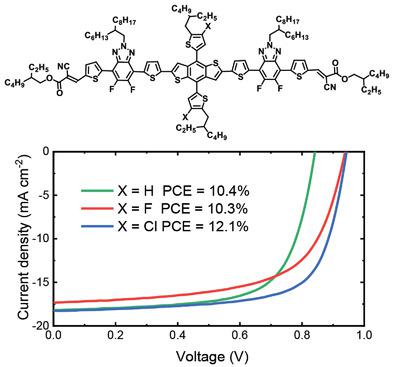当前位置:
X-MOL 学术
›
Adv. Energy Mater.
›
论文详情
Our official English website, www.x-mol.net, welcomes your
feedback! (Note: you will need to create a separate account there.)
Precise Control of Phase Separation Enables 12% Efficiency in All Small Molecule Solar Cells
Advanced Energy Materials ( IF 24.4 ) Pub Date : 2020-08-02 , DOI: 10.1002/aenm.202001589 Haijun Bin 1 , Indunil Angunawela 2 , Beibei Qiu 3 , Fallon J. M. Colberts 4 , Mengmeng Li 1, 5, 6 , Matthew J. Dyson 1 , Martijn M. Wienk 1 , Harald Ade 2 , Yongfang Li 3 , René A. J. Janssen 1, 5
Advanced Energy Materials ( IF 24.4 ) Pub Date : 2020-08-02 , DOI: 10.1002/aenm.202001589 Haijun Bin 1 , Indunil Angunawela 2 , Beibei Qiu 3 , Fallon J. M. Colberts 4 , Mengmeng Li 1, 5, 6 , Matthew J. Dyson 1 , Martijn M. Wienk 1 , Harald Ade 2 , Yongfang Li 3 , René A. J. Janssen 1, 5
Affiliation

|
Compared to conjugated polymers, small‐molecule organic semiconductors present negligible batch‐to‐batch variations, but presently provide comparatively low power conversion efficiencies (PCEs) in small‐molecular organic solar cells (SM‐OSCs), mainly due to suboptimal nanomorphology. Achieving precise control of the nanomorphology remains challenging. Here, two new small‐molecular donors H13 and H14, created by fluorine and chlorine substitution of the original donor molecule H11, are presented that exhibit a similar or higher degree of crystallinity/aggregation and improved open‐circuit voltage with IDIC‐4F as acceptor. Due to kinetic and thermodynamic reasons, H13‐based blend films possess relatively unfavorable molecular packing and morphology. In contrast, annealed H14‐based blends exhibit favorable characteristics, i.e., the highest degree of aggregation with the smallest paracrystalline π–π distortions and a nanomorphology with relatively pure domains, all of which enable generating and collecting charges more efficiently. As a result, blends with H13 give a similar PCE (10.3%) as those made with H11 (10.4%), while annealed H14‐based SM‐OSCs have a significantly higher PCE (12.1%). Presently this represents the highest efficiency for SM‐OSCs using IDIC‐4F as acceptor. The results demonstrate that precise control of phase separation can be achieved by fine‐tuning the molecular structure and film formation conditions, improving PCE and providing guidance for morphology design.
中文翻译:

精确控制相分离可在所有小分子太阳能电池中实现12%的效率
与共轭聚合物相比,小分子有机半导体的批次间差异很小,但目前由于小分子纳米形态的原因,在小分子有机太阳能电池(SM-OSC)中的功率转换效率(PCE)相对较低。实现对纳米形态的精确控制仍然具有挑战性。在这里,展示了两个新的小分子供体H13和H14,它们是由原始供体分子H11的氟和氯取代产生的,它们表现出相似或更高的结晶度/聚集度,并且以IDIC-4F作为受体具有改善的开路电压。由于动力学和热力学原因,H13基于混合的薄膜具有相对不利的分子堆积和形态。相比之下,基于H14的退火共混物表现出良好的特性,即具有最高的聚集度和最小的顺晶π-π畸变,以及具有相对纯净畴的纳米形态,所有这些都可以更有效地产生和收集电荷。结果,与H13的混合物产生的PCE(10.3%)与与H11(10.4%)的混合物相似,而退火的H14基于SM-OSC的PCE明显更高(12.1%)。目前,这代表了使用IDIC-4F作为接收器的SM-OSC的最高效率。结果表明,通过微调分子结构和成膜条件,改善PCE并为形态设计提供指导,可以实现对相分离的精确控制。
更新日期:2020-09-08
中文翻译:

精确控制相分离可在所有小分子太阳能电池中实现12%的效率
与共轭聚合物相比,小分子有机半导体的批次间差异很小,但目前由于小分子纳米形态的原因,在小分子有机太阳能电池(SM-OSC)中的功率转换效率(PCE)相对较低。实现对纳米形态的精确控制仍然具有挑战性。在这里,展示了两个新的小分子供体H13和H14,它们是由原始供体分子H11的氟和氯取代产生的,它们表现出相似或更高的结晶度/聚集度,并且以IDIC-4F作为受体具有改善的开路电压。由于动力学和热力学原因,H13基于混合的薄膜具有相对不利的分子堆积和形态。相比之下,基于H14的退火共混物表现出良好的特性,即具有最高的聚集度和最小的顺晶π-π畸变,以及具有相对纯净畴的纳米形态,所有这些都可以更有效地产生和收集电荷。结果,与H13的混合物产生的PCE(10.3%)与与H11(10.4%)的混合物相似,而退火的H14基于SM-OSC的PCE明显更高(12.1%)。目前,这代表了使用IDIC-4F作为接收器的SM-OSC的最高效率。结果表明,通过微调分子结构和成膜条件,改善PCE并为形态设计提供指导,可以实现对相分离的精确控制。











































 京公网安备 11010802027423号
京公网安备 11010802027423号